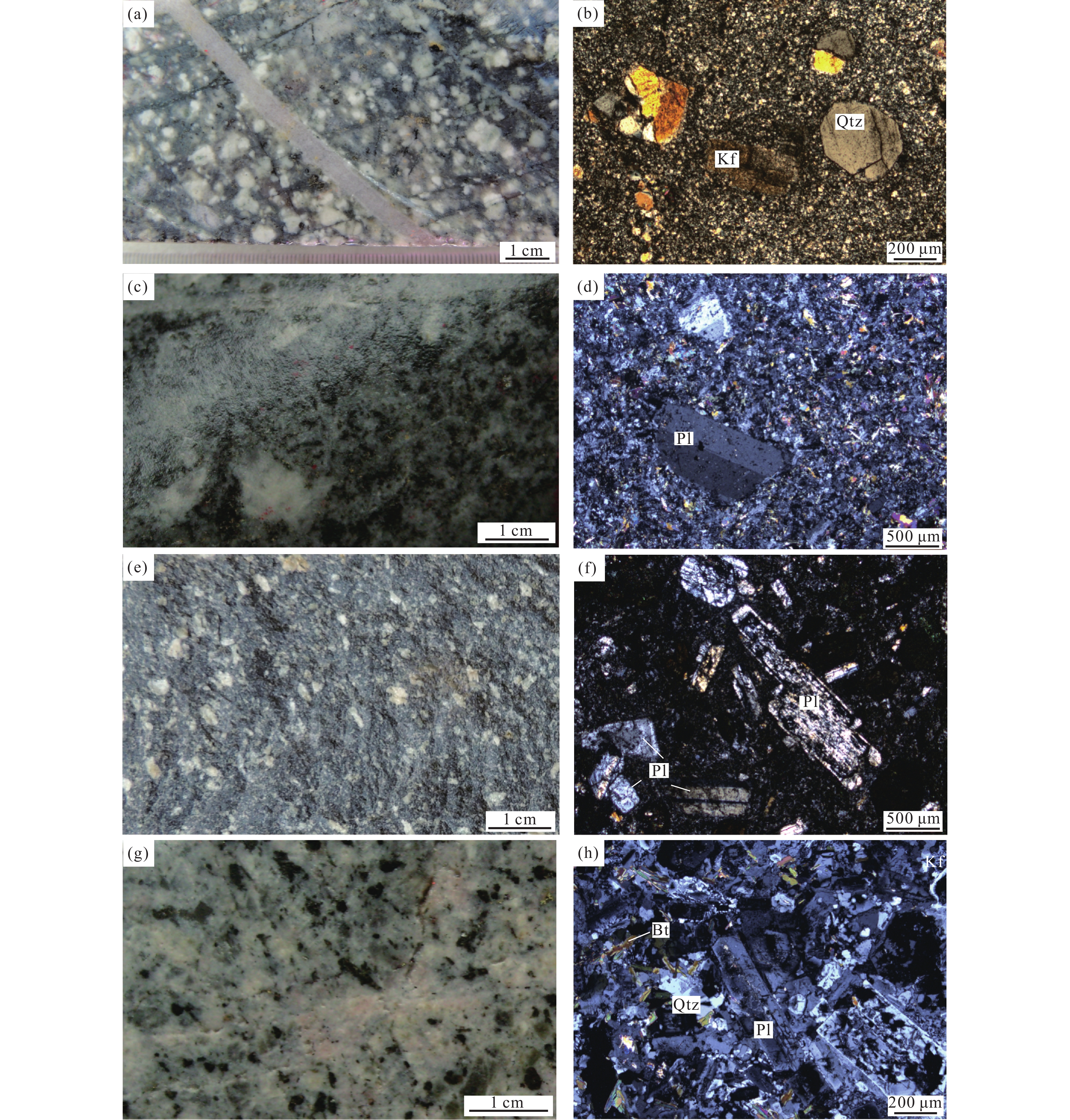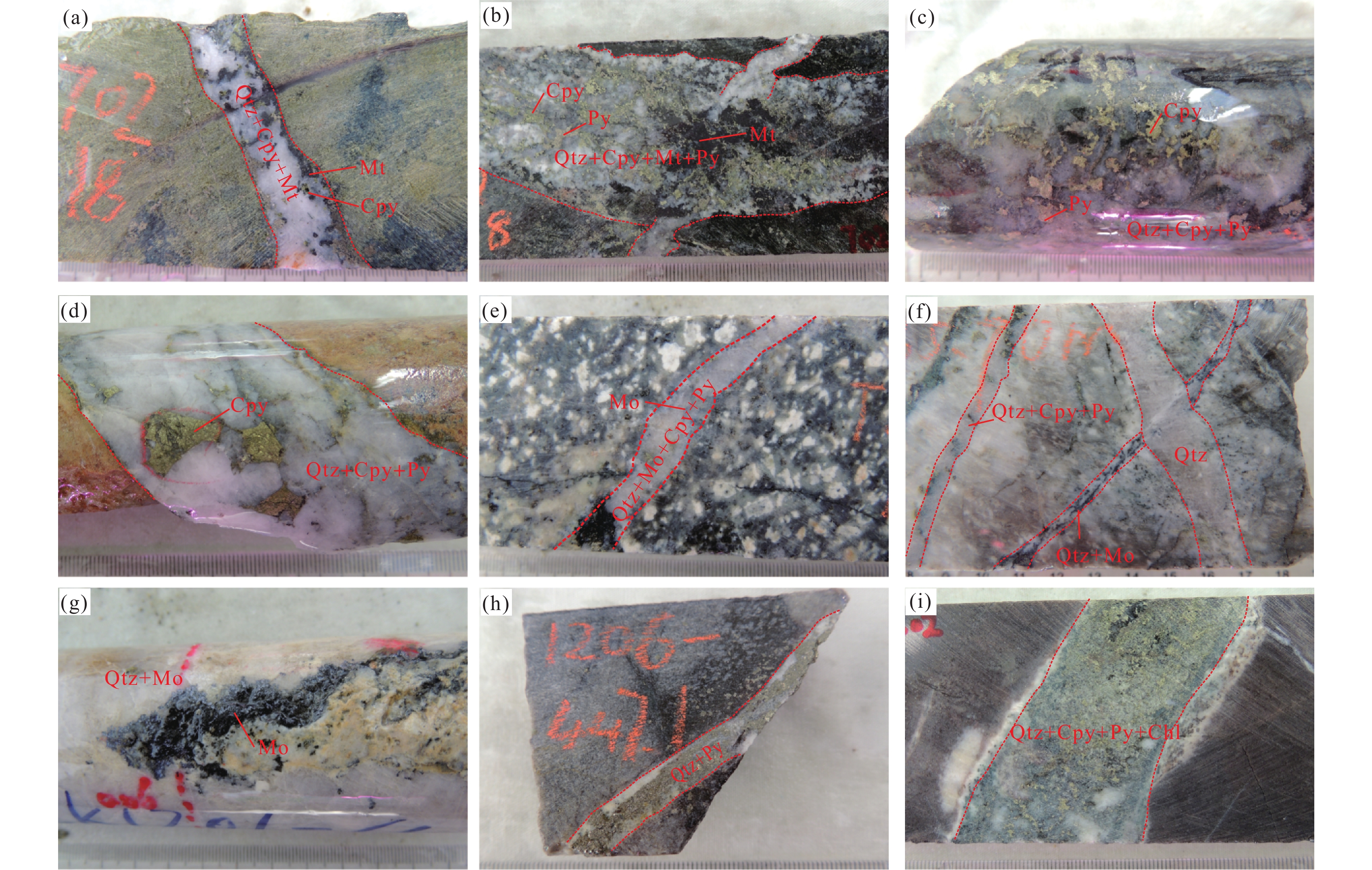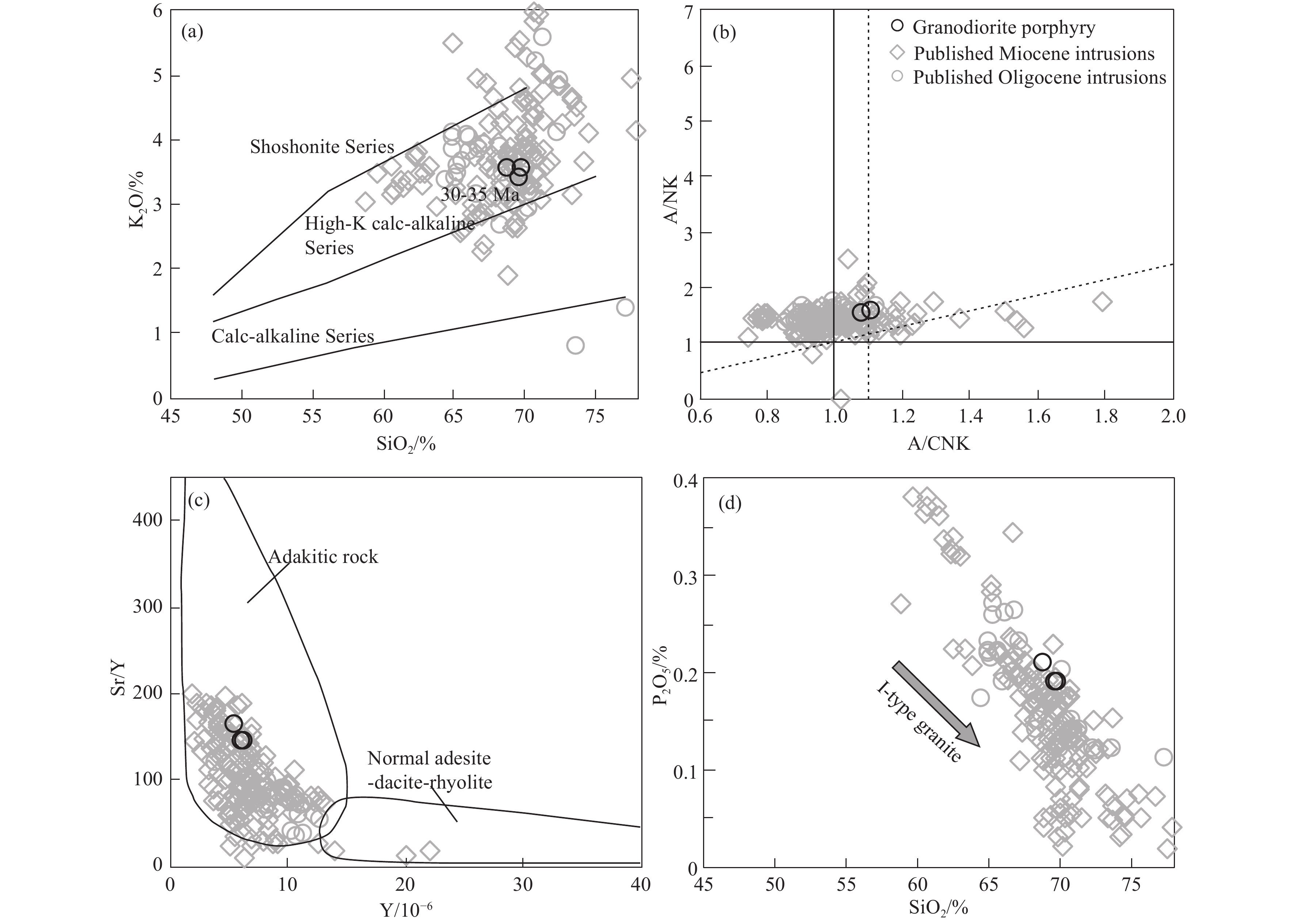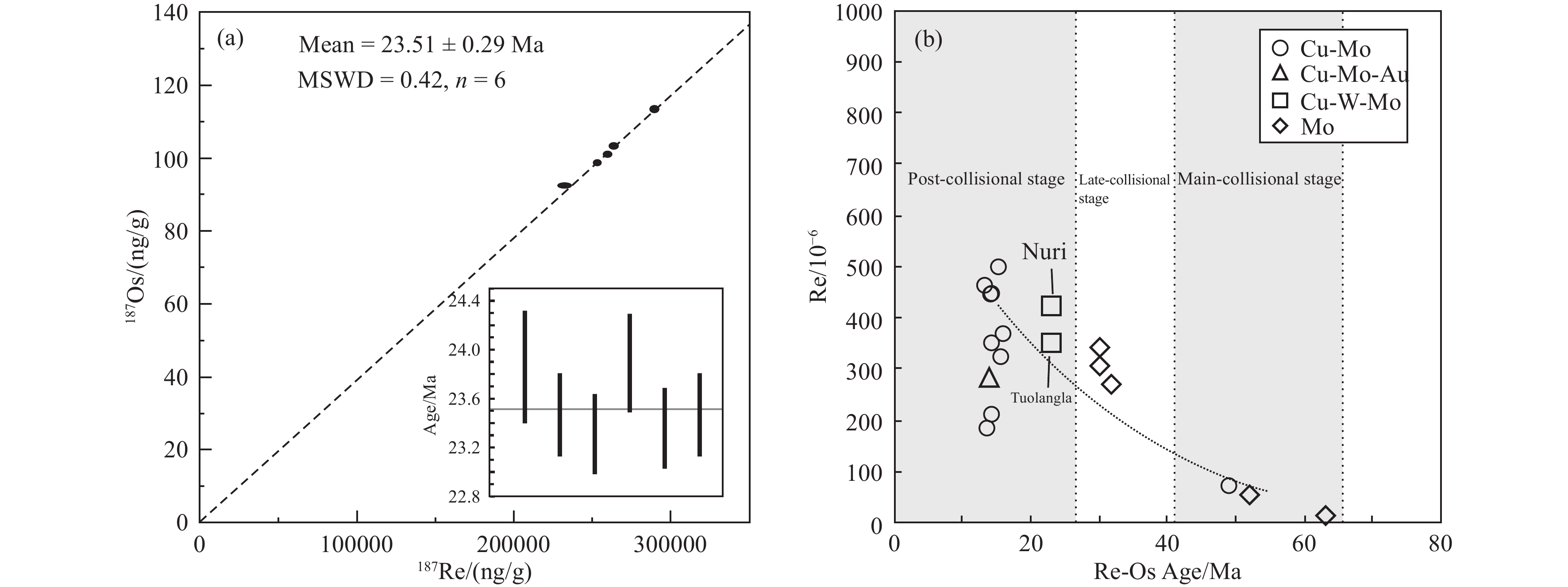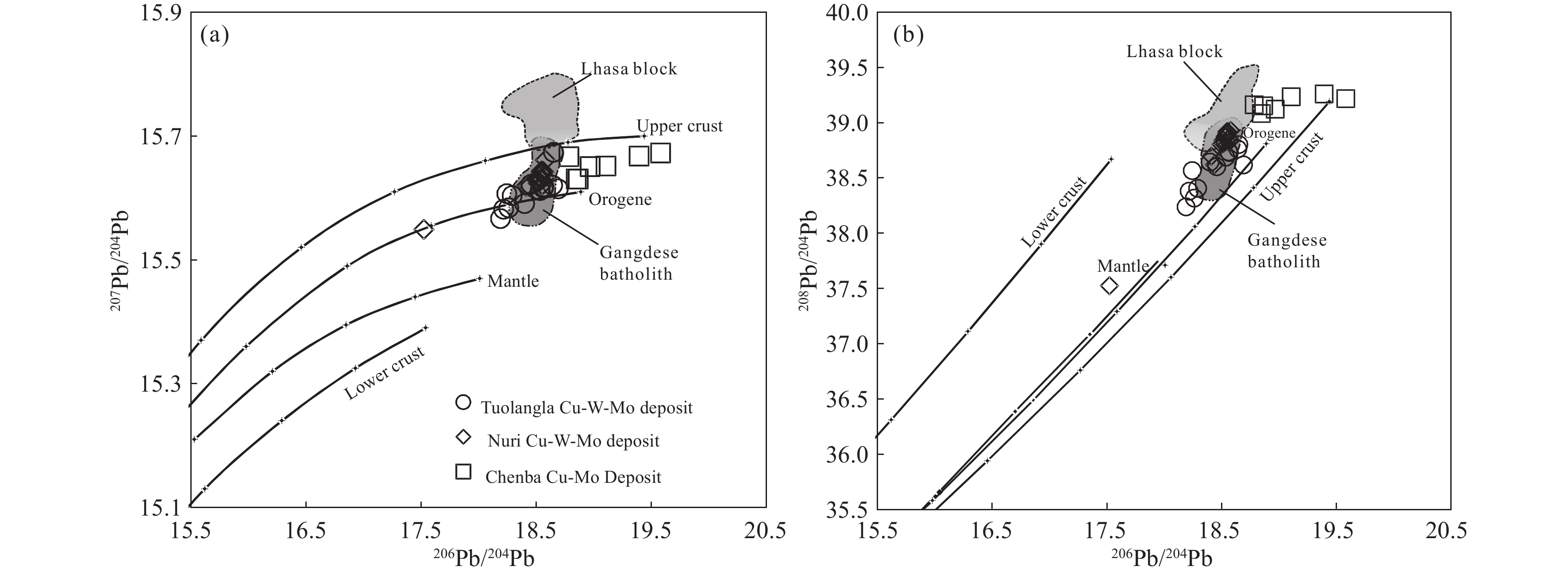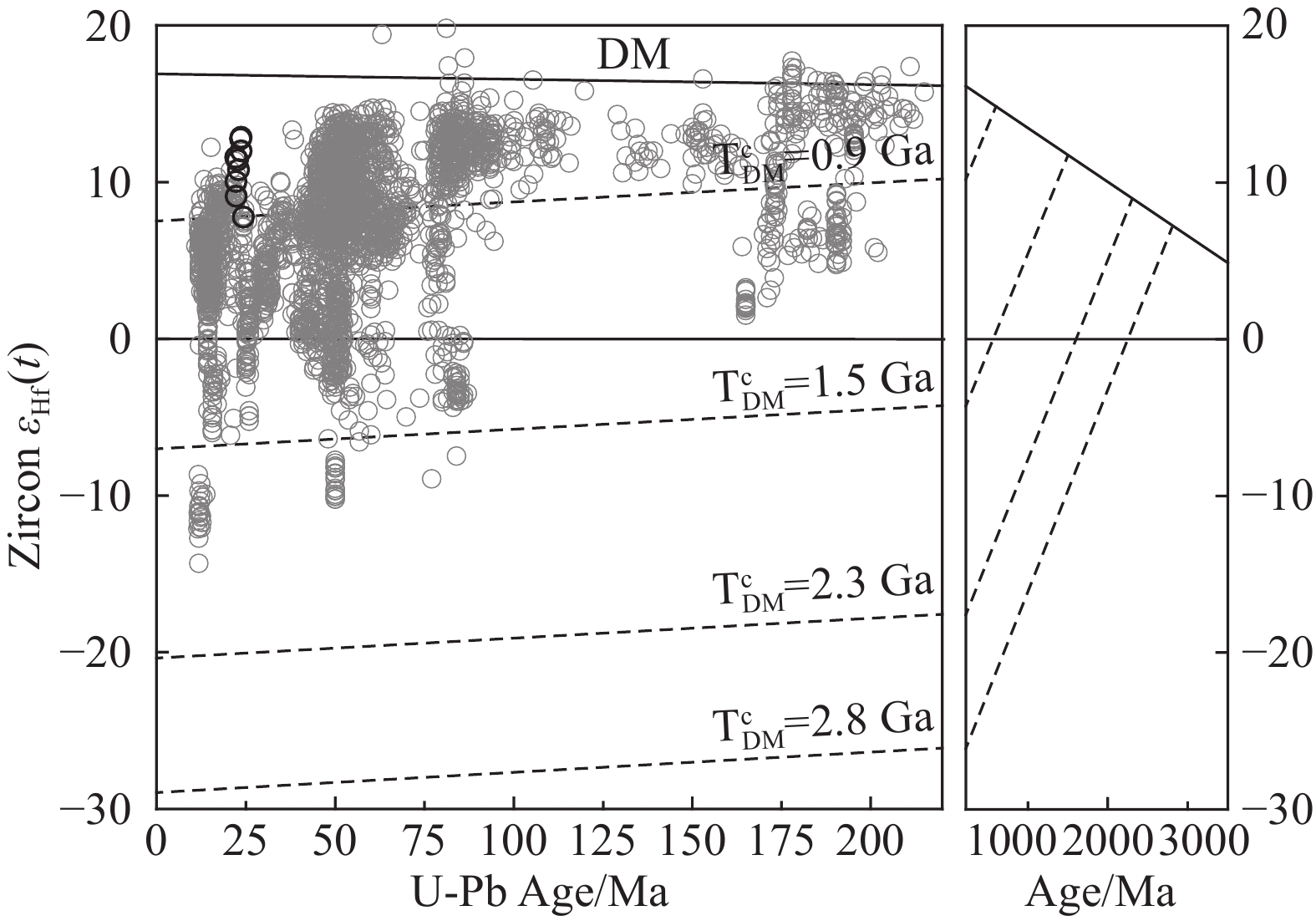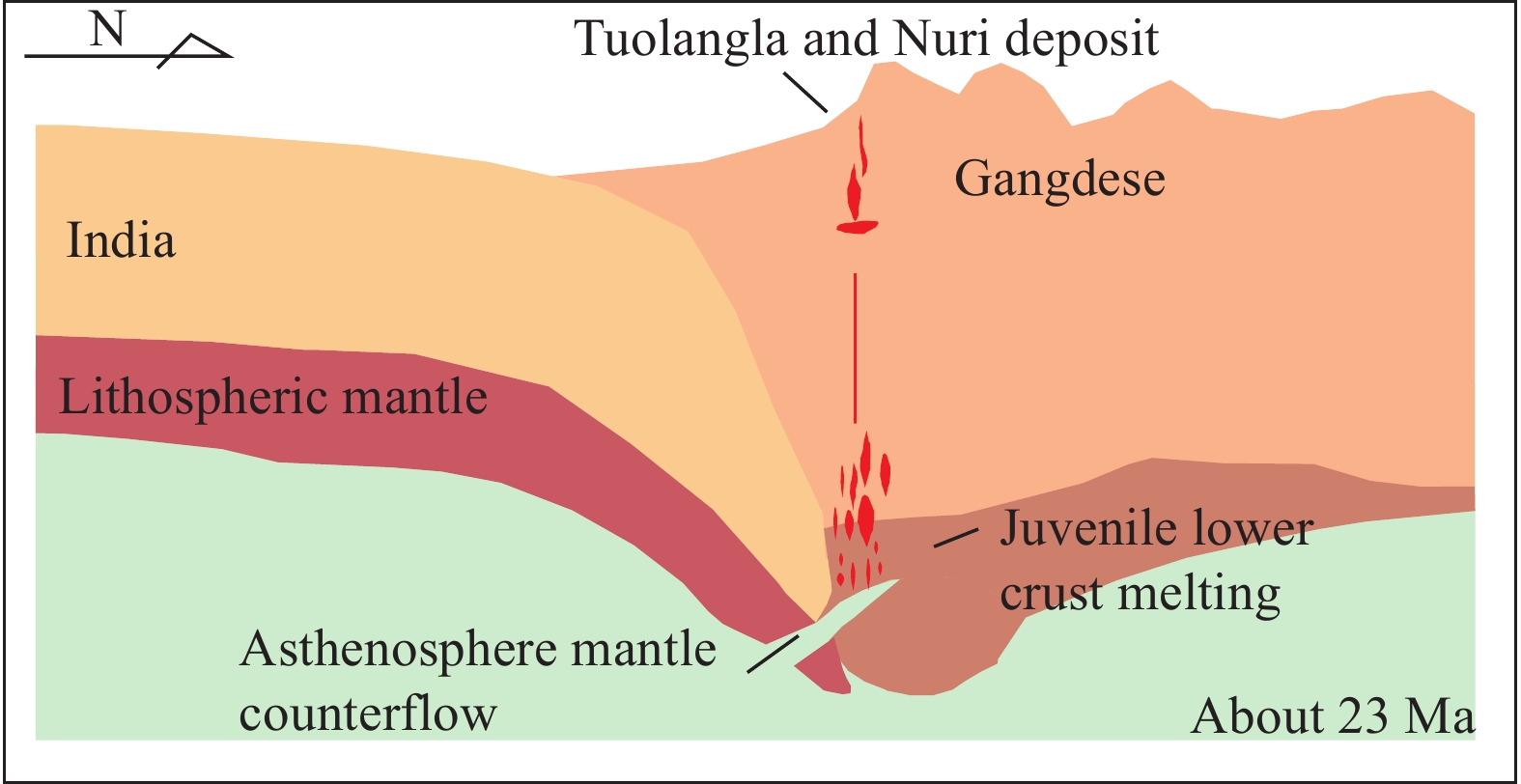| Citation: | Yong Huang, Ming-hua Ren, Wei Liang, Guang-ming Li, Kelly Heilbronn, Zuo-wen Dai, Yi-yun Wang, Li Zhang, 2020. Origin of the Oligocene Tuolangla porphyry-skarn Cu-W-Mo deposit in Lhasa terrane, southern Xizang, China Geology, 3, 369-384. doi: 10.31035/cg2020047 |
Origin of the Oligocene Tuolangla porphyry-skarn Cu-W-Mo deposit in Lhasa terrane, southern Xizang
-
Abstract
Although some porphyry-skarn deposits occur in post-collisional extensional settings, the post-collisional deposits remain poorly understood. Here the authors describe the igneous geology, and mineralization history of Tuolangla, a newly-discovered porphyry-skarn Cu-W-Mo deposit in southern Xizang that belongs to the post-collisional class. The deposit is associated with Lower Cretaceous Bima Formation. It was intruded by granodiorite porphyry intrusions at about 23.1 Ma. Field investigation indicated that mineralization is spatially and temporally associated with granodiorite porphyry. Molybdenite yielded a Re-Os weighted mean age of 23.5 ± 0.3 Ma and is considered to represent the age of skarn mineralization at the deposit. The δ34S values of sulfides, concentrated in a range between 0.6‰ to 3.4‰, show that the sulfur has a homogeneous source with characteristics of magmatic sulfur. The Pb isotopic compositions of sulfides indicate that ore-forming metal materials were derived from the mantle and ancient crust. The granodiorite porphyry displays high SiO2 (68.78%–69.75%) and K2O (3.40%–3.56%) contents, and relatively lower Cr (2.4×10-6–4.09×10-6), Ni (2.79×10-6–3.58×10-6) contents, and positive εHf(t) values (7.7–12.9) indicating that the mineralization porphyry was derived from the partial melting of juvenile lower crust. The Tuolangla deposit is located in the central part of Zedang terrane. This terrane was once considered an ancient terrane. This terrane is in tectonic contact with Cretaceous ophiolitic rocks to its south and Mesozoic continental margin arc volcanics and intrusions of the Gangdese batholith of the Lhasa terrane to its north. Thus, the authors proposed that the Oligocene porphyry skarn Cu-W-Mo mineralization is probably associated with the Zedang terrane. This finding may clarify why the Oligocene (about 23 Ma) deposits are found only in the Zedang area and why mineralization types of the Oligocene mineralization are considerably different from those of the Miocene (17–14 Ma) mineralization.
-
Keywords:
- Porphyry skarn type Cu-W-Mo deposit /
- Geochronology /
- Re-Os isotopic age /
- Zircon U-Pb isotopic age /
- Tuolangla /
- Gangdese belt /
- Xizang /
- China
-

-
References
[1] Aitchison JC, Badengzhu, Davis AM, Liu JB, Luo H, Malpas JG, McDermid IRC, Wu HY, Ziabrev SV, Zhou MF. 2000. Remnants of a Cretaceous intra-oceanic subduction system within the Yarlung-Zangbo suture (southern Xizang). Earth and Planetary Science Letters, 183(1–2), 231–244. [2] Beaudoin G, Hébert R, Wang CS, Tang, J. 2005. Epithermal Au-Ag-Cu, porphyry Cu-(Au-Mo) and Cu-Au-Ag-Zn-Pb skarn deposits of the Gangdese Arc, Xizang. Mineral Deposit Research: Meeting the Global Challenge, Springer Berlin Heidelberg, 1219–1222. [3] Burg JP, Chen GM. 1984. Tectonics and structure zonation of southern Xizang, China. Nature, 311, 219–223. doi: 10.1038/311219a0 [4] Chen L, Qin KZ, Li GM, Li JX, Xiao B, Zhao JX, Fan X. 2015. Zircon U-Pb ages, geochemistry, and Sr-Nd-Pb-Hf isotopes of the Nuri intrusive rocks in the Gangdese area, southern Xizang: Constraints on timing, petrogenesis, and tectonic transformation. Lithos, 212–215, 379–396. doi: 10.1016/j.lithos.2014.11.014 [5] Chung SL, Chu MF, Ji J, O’Reilly SY, Pearson NJ, Liu D, Lee TY, Lo CH. 2009. The nature and timing of crustal thickening in Southern Xizang: Geochemical and zircon Hf isotopic constraints from postcollisional adakites. Tectonophysics, 477(1–2), 36–48. [6] Chung SL, Chu MF, Zhang Y, Xie Y, Lo CH, Lee TY, Lan CY, Li X, Zhang Q, Wang Y. 2005. Xizang tectonic evolution inferred from spatial and temporal variations in post-collisional magmatism. Earth-Science Reviews, 68(3), 173–196. [7] Defant MJ, Drummond MS. 1990. Derivation of some modern arc magmas by melting of young subducted lithosphere. Nature, 347(6294), 662–665. doi: 10.1038/347662a0 [8] Duan LF, Li W, Zheng YC, Liang W, Fu Q, Li QY. 2014. Post-collisional Oligocene metallogenic process in southern margin of Gandise belt: Evidence from Re-Os dating of molybdenite from the Panan porphyry Mo deposit. Acta petrologica ET Mineralogica, 33(2), 307–316 (in Chinese with English abstract). [9] Gao Y, Hou Z, Kamber BS, Wei R, Meng X, Zhao R. 2007. Lamproitic rocks from a continental collision zone: Evidence for recycling of subducted Tethyan oceanic sediments in the mantle beneath Southern Xizang. Journal of Petrology, 48(4), 729–752. doi: 10.1093/petrology/egl080 [10] Gariépy C, Allègre CJ, Xu RH. 1985. The Pb-isotope geochemistry of granitoids from the Himalaya-Xizang collision zone: Implications for crustal evolution. Earth and Planetary Science Letters, 74(2), 220–234. [11] Hou ZQ, Gao YF, Qu XM, Rui ZY, Mo XX. 2004. Origin of adakitic intrusives gener-ated during mid-Miocene east–west extension in southern Xizang. Earth and Planetary Science Letters, 220, 139–155. doi: 10.1016/S0012-821X(04)00007-X [12] Hou ZQ, Yang ZS, Qu XM, Meng XJ, Li ZQ, Beaudoin G, Rui ZY, Gao YF, Zaw K. 2009a. The Miocene Gangdese porphyry copper belt generated during post-collisional extension in the Xizang Orogen. Ore Geology Reviews, 36(1–3), 25–51. [13] Hou ZQ, Cook NJ. 2009b. Metallogenesis of the Xizang collisional orogen: A review and introduction to the special issue. Ore Geology Reviews, 36(1–3), 2–24. doi: 10.1016/j.oregeorev.2009.05.001 [14] Hou ZQ, Zhang HR, Pan XF, Yang ZM. 2011. Porphyry Cu (-Mo-Au) deposits related to melting of thickened mafic lower crust: Examples from the eastern Tethyan metallogenic domain. Ore Geology Reviews, 39(1–2), 21–45. doi: 10.1016/j.oregeorev.2010.09.002 [15] Hou ZQ, Zheng YC, Yang ZM, Yang ZS. 2012. Metallogenesis of continental collision setting: Part Ⅰ. Gangdese Cenozonic porphyry Cu-Mo systems in Xizang. Mineral Deposits, 31(4), 647–670 (in Chinese with English abstract). [16] Hou ZQ, Zhen YC, Yang ZM, Rui ZY, Zhao ZD, Jiang SH, Qu XM, Sun QZ. 2013. Contribution of mantle components within juvenile lower-crust to collisional zone porphyry Cu systems in Xizang. Mineralium Deposita, 48(2), 173–192. doi: 10.1007/s00126-012-0415-6 [17] Hou ZQ, Yang ZM, Lu YJ, Kemp A, Zheng YC, Li QY, Tang JX, Yang ZS, Duan LF. 2015. A genetic linkage between subduction- and collision-related porphyry Cu deposits in continental collision zones. Geology, 43(3), 247–250. doi: 10.1130/G36362.1 [18] Hou ZQ, Zhou Y, Wang R, Zeng YC, He WY, Zhao M, Noreen JE, Roberto FW. 2017. Recycling of metal-fertilized lower continental crust: Origin of non-arc Au-rich porphyry deposits at cratonic edges. Geology, 45(6), 563–566. doi: 10.1130/G38619.1 [19] Huang Y, Li GM, Ding J, Dai J, Yan GQ, Dong SL, Huang HX. 2017. Origin of the newly discovered Zhunuo porphyry Cu-Mo-Au deposit in the western part of the Gangdese porphyry copper belt in the southern Xizang plateau, SW China. Acta Geologica Sinica (English Edition), 91(1), 109–134. doi: 10.1111/1755-6724.13066 [20] Huang Y, Tang JX, Ding J, Zhang L, Lang XH. 2013. The Re-Os isotope system of the Xiongcun porphyry copper-gold deposit, Xizang. Geology in China, 40(1), 302–311 (in Chinese with English abstract). [21] Ji WQ, Wu FY, Chung SL, Li JX, Liu CZ. 2009. Zircon U-Pb geochronology and Hf isotopic constraints on petrogenesis of the Gangdese batholith, southern Xizang. Chemical Geology, 262(3–4), 229–245. [22] Jiang ZQ, Wang Q, Wyman DA, Tang GJ, Jia XH, Yang YH, Yu HX. 2011. Origin of ~30 Ma Chongmuda adakitic intrusive rocks in the southern Gangdese region, south-ern Xizang: Partial melting of the northward subducted Indian continent crust? Geochimica, 40, 126–146 (in Chinese with English abstract). [23] Lee HY, Chung SL, Lo CH, Ji J, Lee TY, Qian ZQ. 2009. Eocene Neotethyan slab breakoff in southern Xizang inferred from the Linzizong volcanic record. Tectonophysics, 477(1–2), 20–35. [24] Li GM, Liu B, Qu WJ, Lin FC, She HQ, Feng CY. 2005. The Porphyry-Skarn ore- Forming system in Gangdese Metallogenic belt, southern Xizang: Evidence from molybdenite Re-Os Age of Porphyry-type copper deposits and Skarn-type copper polymetallic deposits. Geotectonica ET Metallogenic, 29(4), 482–490 (in Chinese with English abstract). [25] Li GM, Qin KZ, Ding KS, Liu TB, Li JX, Wang SH, Jiang SY, Zhang XC. 2006. Geology, Ar-Ar age and mineral assemblage of Eocene skarn Cu-Au±Mo deposits in the Southeastern Gangdese Arc, Southern Xizang: Implications for deep exploration. Resource Geology, 56(3), 315–336. doi: 10.1111/j.1751-3928.2006.tb00286.x [26] Li JX, Qin KZ, Li GM, Xiao B, Chen L, Zhao JX. 2011. Post-collisional ore-bearing adakitic porphyries from Gangdese porphyry copper belt, southern Xizang: Melting of thickened juvenile arc lower crust. Lithos, 126(3–4), 265–277. [27] Luo K, Zhou JX, Huang ZL, Wang XC, Wilde SA, Zhou W, Tian L. 2019. New insights into the origin of early Cambrian carbonate-hosted Pb-Zn deposits in South China: A case study of the Maliping Pb-Zn deposit. Gondwana Research, 70, 88–103. doi: 10.1016/j.gr.2018.12.015 [28] Ludwig KR. 2003. User’s manual for Isoplot 3.00: A geochronological toolkit for Microsoft Excel. Berkeley Geochronology Center Special Publication, (4), 71. [29] Mao JW, Zhang Z, Zhang Z, Du AD. 1999. Re-Os isotopic dating of molybdenites in the Xiaoliugou W (Mo) deposit in the northern Qilian mountains and its geological significance. Geochimica et Cosmochimica Acta, 63(11–12), 1815–1818. [30] Meng XJ, Hou ZQ, Gao YF, Huang W, Qu XM, Qu WJ. 2003. Re-Os dating for molybdenite from Qulong porphyry copper deposit in Gangdese metallogenic belt, Xizang and its metallogenic significance. Geological Review, 49(6), 660–666 (in Chinese with English abstract). [31] Meng YK, Xu ZQ, Xu Y, Ma SW. 2018. Late triassic granites from the Quxu Batholith shedding a new light on the evolution of the Gangdese Belt in Southern Xizang. Acta Geologica Sinica (English Edition), 92(2), 462–481. doi: 10.1111/1755-6724.13537 [32] Miller C, Schuster R, Klötzli U, Frank W, Purtscheller F. 1999. Post-collisional potassic and ultrapotassic magmatism in SW Xizang: Geochemical and Sr-Nd-Pb-O isotopic constraints for mantle source characteristics and petrogenesis. Journal of Petrology, 40(9), 1399–1424. doi: 10.1093/petroj/40.9.1399 [33] Mo XX, Hou ZQ, Niu YL, Dong GC, Qu XM, Zhao, ZD, Yang ZM. 2007. Mantle contributions to crustal thickening during continental collision: Evidence from Cenozoic igneous rocks in southern Xizang. Lithos, 96, 225–242. doi: 10.1016/j.lithos.2006.10.005 [34] Mo XX, Niu YL, Dong GC, Zhao ZD, Hou ZQ, Zhou S, Ke S. 2008. Contribution of syncollisional felsic magmatism to continental crust growth: A case study of the Paleogene Linzizong volcanic Succession in southern Xizang. Chemical Geology, 250(1–4), 49–67. [35] Pan GT, Mo XX, Hou ZQ, Zhu DC, Wang LQ, Li GM, Zhao ZD, Gen QR, Liao ZL. 2006. Spatial-temporal framework of the Gangdese Orogenic belt and its evolution. Acta Petrologica Sinica, 22(3), 521–533 (in Chinese with English abstract). [36] Qu XM, Hou ZQ, Zaw K, Li YG. 2007. Characteristics and genesis of Gangdese porphyry copper deposits in the southern Xizang Plateau: Preliminary geochemical and geochronological results. Ore Geology Reviews, 31(1–4), 205–223. [37] Rui ZY, Hou ZQ, Qu XM, Wang LQ, Wang LS, Liu YL. 2003. Metallogenetic epoch of gangdese porphyry copper belt and uplift of Qianghai-Xizang plateau. Mineral Deposits, 22(3), 217–225 (in Chinese with English abstract). [38] Sillitoe RH. 2010. Porphyry copper systems. Economic Geology, 105, 3–41. doi: 10.2113/gsecongeo.105.1.3 [39] Stacey JS, Kramers JD. 1975. Approximation of terrestrial lead isotope evolution by a two stage model. Earth and Planetary Science Letters, 26, 207–221. doi: 10.1016/0012-821X(75)90088-6 [40] Sun SS, McDonough WF. 1989. Chemical and isotopic systematics of oceanic basalts: implications for mantle composition and processes. Geological Society, 42, 313–345. doi: 10.1144/GSL.SP.1989.042.01.19 [41] Sun X, Zheng YY, Wu S, You ZM, Wu X, Li M, Zhou TC, Dong J. 2013. Mineralization age and petrogenesis of associated intrusions in the Mingze-Chengba porphyry-skarn Mo-Cu deposit, Gangdese. Acta Petrologica Sinica, 29(4), 1392–1406 (in Chinese with English abstract). [42] Sun X, Zheng YY, Xu J, Huang LH, Guo F, Gao SB. 2017. Metallogenesis and ore controls of Cenozoic porphyry Mo deposits in the Gangdese belt of southern Xizang. Ore Geology Reviews, 81, Part 2, 996–1014. [43] Tafti R, Lang JR, Mortensen JK, Oliver JL, Rebagliati CM. 2014. Geology and geochronology of the Xietongmen (Xiongcun) Cu-Au porphyry district, Southern Xizang, China. Economic Geology, 109(7), 1967–2001. doi: 10.2113/econgeo.109.7.1967 [44] Tafti R, Mortensen JK, Lang JR, Rebagliati M, Oliver JL. 2009. Jurassic U-Pb and Re-Os ages for the newly discovered Xietongmen Cu-Au porphyry district, Xizang, PRC: Implications for metallogenic epochs in the southern Gangdese belt. Economic Geology, 104(1), 127–136. doi: 10.2113/gsecongeo.104.1.127 [45] Tang JX, Lang XH, Xie FW, Gao YM, Li ZJ, Huang Y, Ding F, Yang HH, Zhang L, Wang Q, Zhou Y. 2015. Geological characteristics and genesis of the Jurassic No. I porphyry Cu-Au deposit in the Xiongcun district, Gangdese porphyry copper belt, Xizang. Ore Geology Reviews, 70, 438–456. doi: 10.1016/j.oregeorev.2015.02.008 [46] Tang Y, Qin YD, Gong XD, Duan YY, Chen G, Yao HY, Liao JX, Liao SY, Wang DB, Wang BD. 2020. Discovery of eclogites in Jinsha River suture zone, Gonjo County, eastern Xizang and its restriction on Paleo-Tethyan evolution. China Geology, 3, 83–103. doi: 10.31035/cg2020003 [47] Tian SH, Yang ZS, Hou ZQ, Mo XX, Hu WJ, Zhao Y, Zhao XY. 2017. Subduction of the Indian lower crust beneath southern Xizang revealed by the post-collisional potassic and ultrapotassic rocks in SW Xizang. Gondwana Research, 41, 29–50. doi: 10.1016/j.gr.2015.09.005 [48] Turner S, Arnaud N, Liu J, Rogers N, Hawkesworth G, Harris N, Kelley S, Van CP, Deng W. 1996. Post-collision, shoshonitic volcanism on the Xizang Plateau: Implications for convective thinning of the lithosphere and the source of ocean island basalts. Journal of petrology, 37(1), 45–72. doi: 10.1093/petrology/37.1.45 [49] Wang LL, Mo XX, Li B, Dong GC, Zhao ZD. 2006. Geochronology and geochemistry of the ore-bearing porphyry in Qulong Cu(Mo) ore deposit, Xizang. Acta Petrologica Sinica, 22(4), 1001–1008 (in Chinese with English abstract). [50] Wang LQ, Tang JX, Chen W, Luo MC, Jiang HZ, Zhang K. 2014. Sulfur and Lead isotopic geochemistry of the Nuri and Chengba Cu-Mo-W depoisits in Xizang. Acta Geoscientica Sinica, 35(1), 39–48 (in Chinese with English abstract). [51] Wang YY, Zeng LS, Gao LE, Gao JH, Hu ZP, Wang HT, Li GX, Di YL, Shen Y, Xu Q. 2020. Baddeleyite and zircon U-Pb ages of the ultramafic rocks in Chigu Tso area, Southeastern Xizang and their constraints on the timing of Comei Large Igneous Province. China Geology, 3(2), 262–268. doi: 10.31035/cg2020017 [52] Wu CD, Zheng YC, Zhang S, Fu Q, Xu PY. 2015. Ar-Ar Age of Biotite from the Nuri Cu-W-Mo deposit in Xizang, and Its geodynamic significance. Acta Geologica Sinica, 89(9), 1673–1682 (in Chinese with English abstract). [53] Xu WC, Zhang HF, Guo L, Yuan HL. 2010. Miocene high Sr/Y magmatism, south Xizang: Product of partial melting of subducted Indian continental crust and its tectonic implication. Lithos, 114(3–4), 293–306. [54] Yan XY, Huang SF, Du AD. 2010. Re-Os ages of large Tungsten, Copper and Molybdenum deposit in the Zetang orefield, Gangdise and Marginal strike-slip transforming metallogenesis. Acta Geologica Sinica, 84(3), 398–406 (in Chinese with English abstract). [55] Yang YF, Mao JW, Chen YJ, Sun WD, Ni P, Yang XY. 2019. Hydrothermal ore deposits in collisional orogens. Science Bulletin, 64, 205–212. doi: 10.1016/j.scib.2019.01.007 [56] Yang ZM, Hou ZQ, Whit NC, Chang ZS, Li ZQ, Song YC. 2009. Geology of the post-collisional porphyry copper–molybdenum deposit at Qulong, Xizang. Ore Geology Reviews, 36(1–3), 133–159. [57] Yang ZM, Goldfarb R, Chang ZS. 2016. Generation of Postcollisional Porphyry Copper Deposits in Southern Xizang Triggered by Subduction of the Indian Continental Plate[A]//in JP Richards (eds.), Tectonics and Metallogeny of the Tethyan Orogenic Belt, Special Publication No. 19, the Society of Economic Geologists, 392. [58] Yin A, Dubey CS, Webb AAG, Kelty TK, Grove M, Gehrels GE, Burgess WP. 2010. Geologic correlation of the Himalayan orogen and Indian craton: Part 1. Structural geology, U-Pb zircon geochronology, and tectonic evolution of the Shillong Plateau and its neighboring regions in NE India. Geological Society of America Bulletin, 122(3–4), 336–359. [59] Yin A, Harrison TM. 2000. Geologic evolution of the Himalayan-Xizang orogen. Annual Review of Earth and Planetary Sciences, 28(1), 211–280. doi: 10.1146/annurev.earth.28.1.211 [60] Ying LJ, Wang DH, Tang JX, Chang ZS, Qu WJ, Zheng WB, Wang H. 2010. Re-Os dating of Molybdenite from the Jiama polymetallic deposit in Xizang and its metallogenic significance. Acta Geologica Sinica, 84(8), 1165–1174 (in Chinese with English abstract). [61] Ying LJ, Wang CH, Tang JX, Wang DH, Qu WJ, Li C. 2014. Re-Os systematics of sulfides (chalcopyrite, bornite, pyrite and pyrrhotite) from the Jiama Cu-Mo deposit of Xizang, China. Journal of Asian Earth Sciences, 79, 497–506. doi: 10.1016/j.jseaes.2013.10.004 [62] Zartman RE, Doe BR. 1981. Plumbotectonics—the model. Tectonophysics, 75, 135–162. doi: 10.1016/0040-1951(81)90213-4 [63] Zeng YC, Chen JL, Xu JF, Lei M, Xiong QW. 2015. Origin of Miocene Cu-bearing porphyries in the Zhunuo region of the southern Lhasa subterrane: Constraints from geochronology and geochemistry. Gondwana Research, 41, 51–64. [64] Zhang S, Zheng YC, Huang KQ, Li W, Sun QZ, Li QY, Fu Q, Liang W. 2012. Re-Os dating of molybdenite from Nuri Cu-W-Mo deposit and its geological significance. Mineral Deposits, 31(2), 337–346 (in Chinese with English abstract). [65] Zhang SK, Zheng YY, Zhang GY, Gao SB, Sun X, Yu M, Guo JW, Xu Z. 2013. Geochronological constraints on Jigongcun quartz-vein type molybdenum deposit in Quxu County, Xizang. Mineral Deposits, 32(3), 641–648. [66] Zhao JX, Qin KZ, Li GM, Cao MJ, Evans NJ, McInnes BIA, Li JX, Xiao B, Chen L. 2015. The exhumation history of collision-related mineralizing systems in Xizang: Insights from thermal studies of the Sharang and Yaguila deposits, central Lhasa. Ore Geology Reviews, 65, 1043–1061. doi: 10.1016/j.oregeorev.2014.09.026 [67] Zhao JX, Qin KZ, Li GM, Li JX, Xiao B, Chen L, Yang YH, Li C, Liu YS. 2014. Collision-related genesis of the Sharang porphyry molybdenum deposit, Xizang: Evidence from zircon U-Pb ages, Re-Os ages and Lu-Hf isotopes. Ore Geology Reviews, 56, 312–326. doi: 10.1016/j.oregeorev.2013.06.005 [68] Zheng YY, Xiang S, Gao S.B, Wu S, Xu J, Jiang JS, Chen X, Zhao ZY, Liu Y. 2015. Metallogenesis and the minerogenetic series in the Gangdese polymetallic copper belt. Journal of Asian Earth Sciences, 103, 23–39. doi: 10.1016/j.jseaes.2014.11.036 [69] Zhou JX, Wang XC, Wilde SA, Luo K, Huang ZL, Wu T, Jin ZG. 2018a. New insights into the metallogeny of MVT Pb-Zn deposits: A case study from the Nayongzhi in South China, using field data, fluid compositions, and in situ S-Pb isotopes. American Mineralogist, 103, 91–108. doi: 10.2138/am-2018-6238 [70] Zhou JX, Xiang ZZ, Zhou MF, Feng YX, Luo K, Huang ZL, Wu T. 2018b. The giant Upper Yangtze Pb-Zn province in SW China: Reviews, new advances and a new genetic model. Journal of Asian Earth Sciences, 154, 280–315. doi: 10.1016/j.jseaes.2017.12.032 [71] Zhou S, Mo XX, Dong GC, Zhao ZD, Qiu RZ, Guo TY, Wang LL. 2004. 40Ar-39Ar geochronology of Cenozoic Linzizong volcanic rocks from Linzhou Basin, Xizang, China, and their geological implications. Chinese Science Bulletin, 49(18), 1970–1979. doi: 10.1007/BF03184291 [72] Zhu DC, Zhao ZD, Niu Y, Mo XX, Chung SL, Hou ZQ, Wang LQ, Wu FY. 2011. The Lhasa Terrane: Record of a microcontinent and its histories of drift and growth. Earth and Planetary Science Letters, 301(1–2), 241–255. -
Access History

-
Figure 1.
a–Map of regional geology (modified from Yin A and Harrison TM, 2000); b–distribution of ore deposits in the Shannan area, southeastern Gangdese (modified from Chung et al., 2009; Jiang ZQ et al., 2011); c–geologic sketch map of the Tuolangla Cu-W-Mo deposit.
-
Figure 2.
Photographs and micrographs of intrusive rocks in Tuolangla deposit.
-
Figure 3.
Hand specimen of drill-core samples showing different vein types.
-
Figure 4.
Microphotographs of drill-core samples showing the mineralization paragenetic relationship at the Tuolangla deposit.
-
Figure 5.
Zircon U–Pb concordia diagrams ages of intrusive rocks.
-
Figure 6.
Geochemistry plot diagram of granodiorite porphyry.
-
Figure 7.
Primitive mantle normalized multi-element patterns (a) and chondrite-normalized rare earth element (REE) patterns (b) of Tuolangla intrusive rocks.
-
Figure 8.
Molybdenite Re-Os age of the Tuolangla deposit (a) and Re content of porphyry deposits in Gangdese belt (b).
-
Figure 9.
Plumbotectonic diagrams of the ore sulphides in the Tuolangla deposit (after Stacey JS and Kramers JD, 1975; Zartman RE and Doe BR, 1981). Data of Nuri and Chenba from Wang LQ et al. (2014). Lhasa block and Gangdese batholith data from Gariépy C et al. (1985) and are also plotted in the diagram for comparison.
-
Figure 10.
Frequency distribution diagram of δ34S values.
-
Figure 11.
Result of zircon Hf isotope concentrations for granodiorite porphyry from Tuolangla. Published zircon Hf isotope data also plotted on the diagram for reference.
-
Figure 12.
Cartoon model for Oligocene evolution of southern Xizang. Part melting of juvenile lower curst involved of ancient materials (about 23 Ma).





 DownLoad:
DownLoad:
